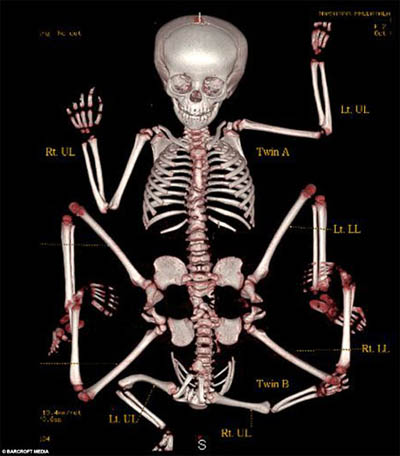Parasitic twin
|
WikiDoc Resources for Parasitic twin |
|
Articles |
|---|
|
Most recent articles on Parasitic twin Most cited articles on Parasitic twin |
|
Media |
|
Powerpoint slides on Parasitic twin |
|
Evidence Based Medicine |
|
Clinical Trials |
|
Ongoing Trials on Parasitic twin at Clinical Trials.gov Trial results on Parasitic twin Clinical Trials on Parasitic twin at Google
|
|
Guidelines / Policies / Govt |
|
US National Guidelines Clearinghouse on Parasitic twin NICE Guidance on Parasitic twin
|
|
Books |
|
News |
|
Commentary |
|
Definitions |
|
Patient Resources / Community |
|
Patient resources on Parasitic twin Discussion groups on Parasitic twin Patient Handouts on Parasitic twin Directions to Hospitals Treating Parasitic twin Risk calculators and risk factors for Parasitic twin
|
|
Healthcare Provider Resources |
|
Causes & Risk Factors for Parasitic twin |
|
Continuing Medical Education (CME) |
|
International |
|
|
|
Business |
|
Experimental / Informatics |
Overview
A parasitic twin (also known as an asymmetrical or unequal conjoined twin) is the result of the processes that produce vanishing twins and conjoined twins, and may represent a continuum between the two. Parasitic twins occur when a twin embryo begins developing in utero, but the pair does not fully separate, and one embryo maintains dominant development at the expense of the other. Unlike conjoined twins, one ceases development during gestation and is vestigial to a mostly fully-formed, otherwise healthy individual twin. The undeveloped twin is defined as parasitic, rather than conjoined, because it is incompletely formed or wholly dependent on the body functions of the complete fetus.
Variants
- Conjoined-parasitic twins united at the head are described as craniopagus or cephalopagus. Craniopagus occipitalis is the term for fusion in the occipital region; craniopagus parietalis is when the fusion is in the parietal region; craniopagus parasiticus is a general term for a parasitic head attached to the head of a more fully-developed fetus or infant.[1]
- The TRAP (twin-reversed arterial perfusion) sequence, results in an acardiac twin, a parasitic twin that fails to develop a head, arms and a heart. The resulting torso survives by leeching blood flow from the surviving normal twin by means of an umbilical cord-like structure, much like a fetus in fetu, except the acardiac twin is not enveloped inside the normal twin's body. Because it is pumping blood for both itself and its acardiac twin, this causes extreme stress on the normal fetus's heart. This twinning condition usually occurs very early in pregnancy.[2]
- Fetus in fetu sometimes is interpreted as a special case of parasitic twin, but may be a distinct entity or a special case of teratoma.
- Ectopic babies form inside the fallopian tube instead of the uterus.
Prognosis
Prognosis for craniopagus parasiticus is generally poor. As of 2007, only three cases are known to have survived childbirth. Everard Home described the first and longest-lived of these, the "Two-Headed Boy of Bengal", who survived until bitten by a cobra in 1787, at the age of four.[3] More recent cases have attracted considerable media attention[4][5] as well as efforts to correct the condition through surgery. An infant girl in the Dominican Republic died in 2004 from complications in surgery.[6] Egyptian doctors, having studied evidence of that operation, successfully removed the parasitic twin from an infant, named Manar Maged, in 2005;[7] however, she succumbed to an infection the following year.[8] The twin removed in this case could smile, blink, cry, and tried to suckle [9] but never developed a body (except a small remnant), or lungs and heart, and instead was dependent on oxygen and nutrients provided by Manar. The case illustrates that there is a continuum from craniopagus parasiticus to the phenomenon of the conjoined twin.
In cases involving the TRAP sequence, without intervention, the mortality rate is approximately 50%. Fetal surgery to cut off the blood supply to the parasite can greatly improve prognosis for the normal fetus, but carries risk of miscarriage or other complications.[10][11]
Examples
{{#ev:youtube|miBIEIehxDE/> <youtube v=UKgTn56KT8Q}}
References
- ↑ Aquino DB, Timmons C, Burns D, Lowichik A (1997). "Craniopagus parasiticus: a case illustrating its relationship to craniopagus conjoined twinning". Pediatric Pathology and Laboratory Medicine. 17 (6): 939–44. PMID 9353833.
- ↑ "Acardiac Twin or TRAP Sequence". University of California, San Francisco. 2007-04-26. Retrieved 2007-05-30.
- ↑ Bondeson J, Allen E (1991). "Everard Home's famous two-headed boy of Bengal and some other cases of craniopagus parasiticus". Surgical Neurology. 35 (6): 483. PMID 2053064.
- ↑ "Joined: The World of Siamese Twins". Channel 4. Retrieved 2007-05-30.
- ↑ "The Oprah Winfrey Show: The Two-Headed Baby Miracle". 2005-05-19. Retrieved 2007-05-30.
- ↑ "Baby born with two heads dies after surgery". CNN. 2004-02-07. Retrieved 2007-05-30.
- ↑ Associated Press (2005-02-23). "Infant Who Had 'Second Head' Removed Doing Well". Fox News. Retrieved 2007-05-30.
- ↑ "Two-head girl dies of infection". BBC News. 2006-03-26. Retrieved 2007-05-30.
- ↑ Channel 4
- ↑ Porreco, Richard P. (Feb 2004). "Percutaneous ultrasonographically guided ablation of an acardiac twin". American Journal of Obstetrics & Gynecology. 190 (2): 572–574.
- ↑ Grab, Deiter; et al. (1992-02-26). "Twin, acardiac, outcome". TheFetus.net. Retrieved 2007-05-30.

